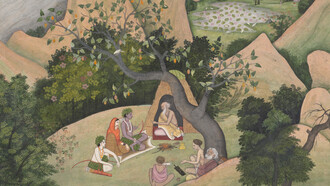World history is nothing but an endless, dreary account of the rape of the weak by the strong.
(Herman Hesse)
For a long time, particularly in schools, history has had the tendency to present our countries in the light of the glorious past, our neighbors in much darker tones, but most of all it has centered on the key moments of structural change. And, of course, it has been stressing the importance of elites, as the transformers, or real subjects of history, while history itself would mainly be interested in what we nowadays call “the western civilization”. We have never been prepared to think of history as the unfolding drama of humanity, and to think of humanity much beyond the happy few. It is time to think globally.
In the 1980s I was asked to review the General History of Africa, the first giant eight-volume effort to bring the continent into the world history, it was coordinated by Ki-Zerbo. This was the history of Africa, not the European deeds in Africa. I had worked several years in different African countries, but I was stunned by my ignorance. How could I know so much about Robespierre but nothing of Sundiata Keita, of the steel production in Mali or Guinea-Bissau’s textile exports to Europe before the invasions. In Brazil people of African origin are a majority, yet all that is taught in schools is about slave-trade; not how the populations lived, worked and organized their cultures and beliefs. A shadow of primitivism was cast over the whole continent. Reading Ki-Zerbo and the numerous authors who contributed to the reconstitution of African history is magic, in the sense that we recognize ourselves in the dramas.
Using history as a looking-glass to perceive ourselves as humanity is presently a necessity, for we are just mankind on this lonely and fragile planet. Ki-Zerbo writes, in the introduction to the first volume:
Nature and men, geography and history, in the introduction to the first volume, have not been kind to Africa. And it is indispensable to go over these fundamental conditions of this process of evolution, in order to state the problems in objective terms and not under the form of aberrant myths such as racial inferiority, congenital tribalism, and the pretense historical passivity of Africans. All these subjective and irrational approaches may only mask voluntary ignorance (25).
Following the African historians, we come to another history concerned with humanity, Howard Zinn’s A People’s History of the United Sates:
It is roughly estimated that Africa lost fifty million human beings to death and slavery in those centuries we call the beginnings of modern Western civilization, at the hands of slave traders and plantation owners in western Europe and America, the countries deemed the most advanced in the world… This unequal treatment, this developing combination of contempt and oppression, feeling and action, which we call “racism”—was this the result of a “natural” antipathy of white against black? If racism can’t be shown to be natural, then it is the result of certain conditions, and we are impelled to eliminate those conditions.
Zinn aims at “a basic human drive toward community” (27). In the slave trade, who were the savages? Europeans were not black, of course.
In the 1600s and the 1700s, by forced exile, by lures, promises, and lies, by kidnapping, by their urgent need to escape the living conditions of the home country, poor people wanting to go to America became commodities of profit for merchants, traders, ship captains, and eventually their masters in America. After signing the indenture, in which the immigrants agreed to pay their cost of passage by working for a master for five or seven years, they were often imprisoned until the ship sailed, to make sure they did not run away (35).
This approach, by historians of different schools and creeds, that we must look at our common challenges, restoring the importance of survival strategies of the common people, beyond Hastings and Waterloo —so to speak— is rich in lessons about humankind. Another similar effort has been undertaken by Polish historian Adam Leszczynski, in the recently published Ludowa Historia Polski (A People’s History of Poland), with explicit reference to Zinn’s work on the USA. Kings and magnates do show up in the book, but it is centered on the daily struggles of the immense majority to survive the successive forms of bondage.
I was aware of the different and violent forms of oppression in Poland, particularly with the classic studies by Witold Kula on feudalism. But a detailed history of the concrete and sophisticated forms of oppression, starting in 996, and brought up to present times, deeply changes the perspective. It is not the history of what wars and palaces the elites promoted or built with the extorted surplus, but how the extorsion systems changed in forms, and remained in content.
This is not so different from what happened with Brazil, where the social divide is fully present in 2021.
In the XVIII century, the Republic [of Poland] was a very poor peripheral country governed by a small elite of a few percent of the population, which exported to the West agricultural products created under slavery (niewolnicza praca), enriching in the way a long chain of foreign middle-men (530).
Oppression, export of agricultural products, and import of luxury goods for the “happy few”, is not particularly Polish, and the author mentions developing countries and colonies in their similarity. Curiously, Witold’s son Marcin Kula, with whom Leszczynski studied, did compare Brazil and Poland.
An important dimension of the system consisted in redirecting the very numerous upheavals against foreigners, and particularly Jews, a stratagem widely used during in Poland during centuries, but also in so many countries in so many centuries, and so deeply mixed with racism: America First, Deutschland Über Alles, the “chosen people” myth, so many patriotic hymns, the use of religions: all create an ideological legitimacy for cynical oppression. Here we find a common denominator of oppressive regimes: the guilt has to be external. The catharsis of hatred of “the different” plays such an important part in the oppression machinery.
Thomas Piketty is an economist, but Capital in the 20th Century owes its over 800 pages not to the subject —surplus extraction— but to the historical reconstruction of how the surplus was extracted in different periods, with ample reference, for example, to Balzac. This is not a préciosité, for in building his Comédie Humaine Balzac describes in impressive detail how surplus was extracted, through rent on real estate, and particularly debt, from which he suffered during all his life. In his novels, Balzac made sure that the different personnages of the society he describes are present, and the key inner workings shown. Real history in fiction.
A key issue in Piketty’s book is that the production of goods and services —what we call GDP— grows on average around 2.5 percent a year; while rent extracted through financial mechanisms such as indebtedness, dividends, real estate speculation and the like is much higher; the capital goes to where it pays more, particularly if you do not need to face the effort of producing something. But in the more recent Capital and Ideology, Piketty goes beyond the workings of surplus extraction, detailing how in different periods and different countries the powerful created different ideologies to justify their right to what they did not produce. It certainly goes beyond this, and the final part of the book presents practical changes which would enable us to create a more just and stable society. But the key issue is that the elites have always managed to create sophisticated justification for what Gar Alperovitz called “unjust deserts”. Piketty calls it ideology, in Brazil we call them narrativas.
All in all, what history shows us, is that on different continents, cultures and times, minorities exerted their power by creating solid mechanisms of extraction of the surplus produced by the many. Understanding the economic mechanism is essential, as is shown in recent studies on financialization. But the social surplus has also been taken over with the help of narratives: the kings had blue blood and were anointed by God, the slaves had no soul, capitalists earn profit as naturally as workers earn salaries, rentiers are awarded by the risk they take with the money they speculate with and so on. The docility with which so many civilizations have accepted the narratives is impressive. But for those who do not believe in narratives, there is always the stick, a third essential component of the system.
What do these popular historians teach us? This is how societies work: an economic surplus extraction mechanism, powerful narratives, and the stick for those who do not buy them. Our challenge goes far beyond changing the economy.















